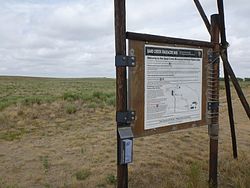Sand Creek Massacre Monument and Bluffs
Sand Creek Massacre National Historic Site commemorates the November 29, 1864, attack on a village of about 700 Southern Cheyenne and Arapaho people along Sand Creek. At dawn, approximately 675 soldiers of the 1st and 3rd Regiments, Colorado Volunteer (U.S.) Cavalry, killed more than 230 Cheyenne and Arapaho over the course of seven hours. Most were women, children, or the elderly. The site’s History & Culture overview provides an in-depth look into the background of this atrocity and surrounding events, including letters written by witnesses immediately afterwards.
Visitors can learn more about this tragic period through a ranger-led interpretive program, printed material and signage, and a self-guided hike along the path of the massacre.
This route travels the full trail, though the distance from visitor center to just the Battle Ground and Repatriation Site is only 0.6 miles each way. It’s also possible to park at a secondary lot adjacent to those sites.
All walking trails at the park are sand-based with a ¼-inch crusher fine walking surface. They are compatible for wheelchair use; however, rain/snow and/or patches of soft sand may impede wheelchair use. Read more about accessibility. Temperatures range from over 100°F in summer to under 20°F in winter. Visitors can expect blowing dust and sand year-round, especially during infrequent storms.
Hiking
- Out & Back
- History
- Wheelchair Friendly



Any visit should begin with a stop at the Information Center, if open. Daily interpretive programs typically start in April and run through the summer, but check the hours first. Entrance is free. Drinking water is available at the Ranger Station seasonally.
This area includes an overlook above Big Sandy Creek, a shade structure, and the Repatriation Area. While referred to as a battle ground on the monument, it is the site of a horrific massacre that deserves respect and remembrance. If possible, attending an interpretive program can help make the most of your visit. Even if you miss a scheduled program, don’t hesitate to ask about the possibility of an unscheduled talk or walk. Spending time to read interpretive material on-site and website in advance is highly encouraged as well.


Massacre victims are slowly being returned to this resting place, with the first remains being reburied in 2008.

